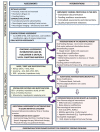Feeding Problems and Long-Term Outcomes in Preterm Infants-A Systematic Approach to Evaluation and Management
- PMID: 34943354
- PMCID: PMC8700416
- DOI: 10.3390/children8121158
Feeding Problems and Long-Term Outcomes in Preterm Infants-A Systematic Approach to Evaluation and Management
Abstract
Preterm infants are known to have long-term healthcare needs. With advances in neonatal medical care, younger and more preterm infants are surviving, placing a subset of the general population at risk of long-term healthcare needs. Oral feeding problems in this population often play a substantial yet under-appreciated role. Oral feeding competency in preterm infants is deemed an essential requirement for hospital discharge. Despite achieving discharge readiness, feeding problems persist into childhood and can have a residual impact into adulthood. The early diagnosis and management of feeding problems are essential requisites to mitigate any potential long-term challenges in preterm-born adults. This review provides an overview of the physiology of swallowing and oral feeding skills, disruptions to oral feeding in preterm infants, the outcomes of preterm infants with feeding problems, and an algorithmic approach to the evaluation and management of neonatal feeding problems.
Keywords: deglutition; dysphagia; feeding problems; fiberoptic endoscopic evaluation of swallowing (FEES); manometry; oral feeding; outcomes; prematurity; videofluoroscopic swallow study (VFSS).
Conflict of interest statement
The authors declare no conflict of interest.
Figures




References
-
- Martin J.A., Osterman M.J.K. Describing the Increase in Preterm Births in the United States, 2014–2016. National Center for Health Statistics; Hyattsville, MD, USA: 2018. NCHS Data Brief, No 312.
-
- Stoll B.J., Hansen N.I., Bell E., Walsh M.C., Carlo W.A., Shankaran S., Laptook A.R., Sánchez P.J., Van Meurs K.P., Wyckoff M., et al. Trends in Care Practices, Morbidity, and Mortality of Extremely Preterm Neonates, 1993–2012. JAMA. 2015;314:1039–1051. doi: 10.1001/jama.2015.10244. - DOI - PMC - PubMed
-
- Behrman R.E., Butler A.S., editors. Preterm Birth: Causes, Consequences, and Prevention. Washington (DC): National Academies Press (US); 2007. [(accessed on 10 November 2021)]; Institute of Medicine (US) Committee on Understanding Premature Birth and Assuring Healthy Outcomes. 12, Societal Costs of Preterm Birth. Available online: http://www.ncbi.nlm.nih.gov/books/NBK11358/ - PubMed
Publication types
LinkOut - more resources
Full Text Sources
Medical

